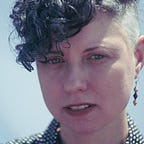How to Name Your Characters
Without ruining your life and losing all your friends
Confession: I once named characters in a short story “X” and “Y.” In my defense I was young and it was the aughts, when I thought I could tear down the temple of narrative with this one precious technique. Please know that I’ve done a lot of growing up since then and gone through several methods of naming characters.
For my first novel I found myself in a Nabokovian Name phase that I’m still a little too fond of, where each character’s name is some kind of poetic or aesthetic reference that’s revealing of their nature. Shitty men with the last name “Mann” or confused young women named “Hayes” (haze, hazy, get it?). I know it’s a little shy of brilliant, but for me it was always a simple way into the character, a starting point at least.
And it’s easy to get very attached to the name of the person you created. When I was writing The Blondes and had named my protagonist Hazel, I learned a close friend who was pregnant was planning to name their child Hazel. I offered to change the character’s name, but she didn’t want to affect my book and decided to go with her second choice name. I’m mildly horrified now that my response was, “Okay, that’s settled.”
As I’ve grown as a writer I learned to put the sociologically accurate before the meaningful in terms of names. When was the character born? What part of the country? Aging also means meeting a lot of people, and naming a character Mark is more complicated when you’ve met eight or nine Marks. What if one of them — Mark from high school who’s now an EDM musician or Mark the guy who wrote the Garfield movie you had a meeting with once — reads the novel and thinks the film school dropout character is them? It’s also healthy to admit these fears are predicated on friends actually reading your book and trust me, all writers learn to not ask that question after a while.
Sometimes you can’t argue with randomly taking a name from the world, something overheard, or spotted in the wild. In my novel Little Threats the mother character Marley came from a construction company billboard on the BQE. Its logo was a bucking horse and it seemed to fit the character. In these cases I can empty the name of all but the meaning I want it to contain. There’s room for the real-but-not-real person that is being created.
You might also be tempted use the name of someone you hate, as a secret revenge, but you’ll eventually regret it. The novel is one of the last intimate spaces totally owned by its creator and it’s best not to invite that person into it forever.
I won’t wade too much into auto fiction and the act of literally naming names except to say the choice is personal, and occasionally legal. For me, I would never give up the protection of fiction and the powerful tool of creating a name. In Little Threats the naming of the twin daughters, Carter and Kennedy, even turned into an important part of the story.
Gerry Wynn had chosen his daughters’ names after presidents, so they would know anything was possible. If they’d been boys they would have been Jack and Jimmy, or more formally John and James. But thirty-one years ago they had been handed to him screaming, pink, and female.
I did this on purpose as a window into the family’s identity, and how a patriarch put pressure on his children from the first moment of their lives. I thought it made sense but, of course, there’s an online review where a reader declared she, “couldn’t get past the weird names.” So there. You can’t make everyone happy, least of all Ingrid von Otter of Minneapolis.
Confession: I gave that reader a new name. It’s that easy.
